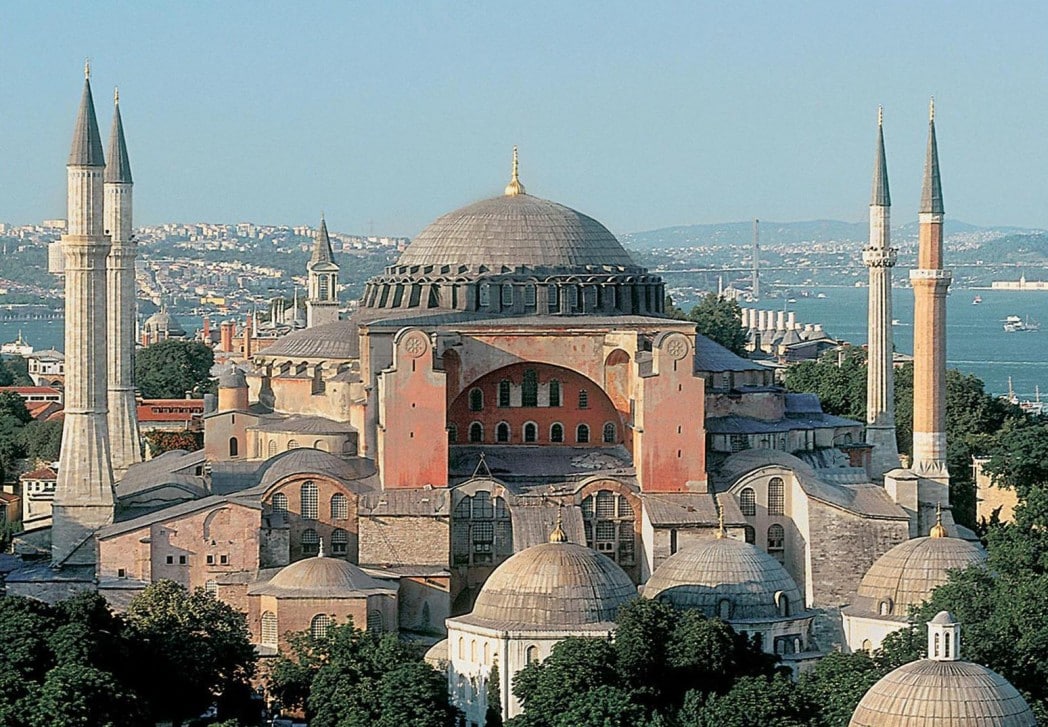The Hagia Sophia: 1600 Years Of History And Engineering

Table of Contents
The Hagia Sophia's Byzantine Construction (532-537 AD): A Marvel of Engineering
The construction of the Hagia Sophia, commissioned by the Byzantine Emperor Justinian I, represents a pinnacle of 6th-century engineering. Its creation involved a remarkable blend of innovative materials and construction techniques, pushing the boundaries of architectural possibilities at the time.
The Innovative Use of Materials:
The Hagia Sophia's enduring strength is a testament to the quality of its materials and the skill of its builders.
- Brick, Stone, and Mortar: Layers of brick and carefully selected stone were bound together with high-quality mortar, creating a structure capable of withstanding centuries of earthquakes and weathering. The sourcing of these materials from across the Byzantine Empire presented significant logistical challenges, highlighting the scale of the project.
- Pendentives: The ingenious use of pendentives – triangular sections of masonry – was crucial to the dome's support. These architectural elements smoothly transitioned the weight of the dome from a circular base to the square supporting piers below, a breakthrough in architectural engineering that allowed for the creation of such a vast, unsupported dome.
- Sophisticated Construction Techniques: The construction of the massive dome involved complex scaffolding and hoisting systems, reflecting advanced engineering knowledge. Workers employed sophisticated techniques to precisely place each stone and brick, ensuring structural integrity.
The Grandeur of the Dome:
The Hagia Sophia's dome is arguably its most striking feature.
- Impressive Size and Innovative Design: With a diameter of 31 meters (102 feet) and a height of 55.6 meters (182 feet), the dome was a feat of engineering for its time. Its innovative design, incorporating lighter materials like pumice in the concrete mix to reduce weight, was essential to its stability.
- Visual Impact: The sheer size and height of the dome created an overwhelming sense of awe and grandeur for visitors, symbolizing the power and magnificence of the Byzantine Empire. The vast interior space, filled with light, made it a truly awe-inspiring space for religious ceremonies.
- Comparison to Other Domes: While Roman domes like the Pantheon existed, the Hagia Sophia's dome represented a significant advancement. Its larger size and the use of pendentives to support it marked a significant leap forward in dome construction technology.
Centuries of Transformation: From Cathedral to Mosque and Museum
The Hagia Sophia's history is not just about its initial construction, but also its remarkable transformations over the centuries. Its status as a cathedral, mosque, and museum reflects the shifting political and religious landscapes of Istanbul.
The Hagia Sophia as a Cathedral:
For nearly a thousand years, the Hagia Sophia served as the central cathedral of the Eastern Orthodox Church.
- Religious and Political Center: It was the heart of the Byzantine Empire's religious and political life, hosting imperial ceremonies and significant religious events.
- Iconoclasm: The period of iconoclasm (the destruction of religious images) in the 8th and 9th centuries significantly impacted the Hagia Sophia's interior decoration. Many icons were destroyed and later restored.
- Artistic and Decorative Features: The cathedral was richly adorned with mosaics, frescoes, and other artistic elements reflecting Byzantine artistic traditions, although much was lost or altered over the centuries.
The Ottoman Era and Conversion to a Mosque:
The Ottoman conquest of Constantinople in 1453 marked a pivotal moment in the Hagia Sophia's history.
- Conversion to a Mosque: Sultan Mehmed II converted the Hagia Sophia into a mosque, initiating modifications to align it with Islamic religious practices.
- Ottoman Modifications: The addition of minarets (tall towers from which the call to prayer is given), mihrabs (prayer niches indicating the direction of Mecca), and other Islamic architectural features transformed the building's exterior and interior.
- Artistic and Decorative Changes: Many Byzantine mosaics and frescoes were covered, while new Islamic decorative elements were introduced.
- Significant Figures and Events: The Hagia Sophia played a central role in the religious life of Ottoman Istanbul, hosting prayers and religious ceremonies for centuries.
The Hagia Sophia as a Museum and its Modern Significance:
In 1935, the Hagia Sophia was declared a museum under the secular Republic of Turkey. However, this status changed again in 2020.
- Museum Designation and Re-designation: Its designation as a museum allowed for the restoration and preservation of its historical artifacts, making it accessible to a wider audience. The 2020 decision to re-establish it as a mosque sparked considerable international debate.
- UNESCO World Heritage Site: Its inclusion as a UNESCO World Heritage Site underscores its global importance as a unique and irreplaceable historical monument.
- Symbol of Cultural Exchange: The Hagia Sophia's journey from cathedral to mosque and back symbolizes the complex cultural and religious exchanges that have shaped Istanbul and Turkey throughout history.
Architectural and Engineering Innovations of the Hagia Sophia
The Hagia Sophia's enduring legacy is deeply intertwined with its groundbreaking architectural and engineering innovations.
The Pendentives and their Structural Significance:
The Hagia Sophia's pendentives represent a critical architectural advancement.
- Function and Genius: These curved triangular structures ingeniously solved the challenge of supporting a massive dome on a square base, efficiently distributing the weight.
- Transition from Square to Round: The pendentives seamlessly transition the weight from the square plan of the building's base to the circular shape of the dome, a remarkable feat of architectural engineering.
- Comparison to Other Structures: While other structures had used pendentives, the Hagia Sophia's scale and the complexity of its design pushed the boundaries of this technique.
The Use of Light and Space:
The Hagia Sophia's masterful manipulation of light and space creates a truly breathtaking interior.
- Natural Light: Large windows, strategically positioned high in the walls, flood the interior with natural light, creating a dramatic interplay of shadow and light.
- Impact of Windows: The placement of the windows influences the mood and atmosphere of the interior, changing throughout the day.
- Vast Interior Space: The combination of natural light and the immense interior space generates a profound sense of awe and grandeur, emphasizing the building's spiritual and symbolic significance.
Conclusion
The Hagia Sophia stands as an unparalleled achievement of Byzantine engineering and a symbol of Istanbul's rich and layered history. From its innovative construction techniques to its transformative role across centuries, the Hagia Sophia continues to fascinate and inspire. Its architectural brilliance and enduring legacy serve as a powerful reminder of human creativity and the enduring power of historical monuments. Learn more about this magnificent structure and explore the captivating details of its history by researching the Hagia Sophia further—its enduring story is waiting to be fully discovered.

Featured Posts
-
 David Rosenberg Was The Bank Of Canada Too Timid
Apr 29, 2025
David Rosenberg Was The Bank Of Canada Too Timid
Apr 29, 2025 -
 Negative European Electricity Prices A Solar Power Success Story
Apr 29, 2025
Negative European Electricity Prices A Solar Power Success Story
Apr 29, 2025 -
 How You Tube Caters To The Preferences Of Older Viewers
Apr 29, 2025
How You Tube Caters To The Preferences Of Older Viewers
Apr 29, 2025 -
 D C Mid Air Collision Separating Fact From Fiction On Social Media
Apr 29, 2025
D C Mid Air Collision Separating Fact From Fiction On Social Media
Apr 29, 2025 -
 Willie Nelson New Album Release And Family Controversy
Apr 29, 2025
Willie Nelson New Album Release And Family Controversy
Apr 29, 2025
Latest Posts
-
 Will Trump Pardon Rose A Complete Analysis
Apr 29, 2025
Will Trump Pardon Rose A Complete Analysis
Apr 29, 2025 -
 Trump To Issue Full Pardon For Rose Latest Updates
Apr 29, 2025
Trump To Issue Full Pardon For Rose Latest Updates
Apr 29, 2025 -
 You Tubes Growing Appeal To Older Viewers Nostalgia And Accessibility
Apr 29, 2025
You Tubes Growing Appeal To Older Viewers Nostalgia And Accessibility
Apr 29, 2025 -
 How You Tube Caters To The Preferences Of Older Viewers
Apr 29, 2025
How You Tube Caters To The Preferences Of Older Viewers
Apr 29, 2025 -
 You Tube A Platform For Classic Tv Shows And Older Viewers
Apr 29, 2025
You Tube A Platform For Classic Tv Shows And Older Viewers
Apr 29, 2025
